JavaScript is disabled for your browser. Some features of this site may not work without it.
Buscar en RiuNet
Listar
Mi cuenta
Estadísticas
Ayuda RiuNet
Admin. UPV
Archetype Modeling Methodology
Mostrar el registro sencillo del ítem
Ficheros en el ítem
| dc.contributor.author | Moner Cano, David
|
es_ES |
| dc.contributor.author | Maldonado Segura, José Alberto
|
es_ES |
| dc.contributor.author | Robles Viejo, Montserrat
|
es_ES |
| dc.date.accessioned | 2019-07-25T20:01:18Z | |
| dc.date.available | 2019-07-25T20:01:18Z | |
| dc.date.issued | 2018 | es_ES |
| dc.identifier.issn | 1532-0464 | es_ES |
| dc.identifier.uri | http://hdl.handle.net/10251/124220 | |
| dc.description.abstract | [EN] Clinical Information Models (CIMs) expressed as archetypes play an essential role in the design and development of current Electronic Health Record (EHR) information structures. Although there exist many experiences about using archetypes in the literature, a comprehensive and formal methodology for archetype modeling does not exist. Having a modeling methodology is essential to develop quality archetypes, in order to guide the development of EHR systems and to allow the semantic interoperability of health data. In this work, an archetype modeling methodology is proposed. This paper describes its phases, the inputs and outputs of each phase, and the involved participants and tools. It also includes the description of the possible strategies to organize the modeling process. The proposed methodology is inspired by existing best practices of CIMs, software and ontology development. The methodology has been applied and evaluated in regional and national EHR projects. The application of the methodology provided useful feedback and improvements, and confirmed its advantages. The conclusion of this work is that having a formal methodology for archetype development facilitates the definition and adoption of interoperable archetypes, improves their quality, and facilitates their reuse among different information systems and EHR projects. Moreover, the proposed methodology can be also a reference for CIMs development using any other formalism. | es_ES |
| dc.description.sponsorship | This work was partially funded by grant DI-14-06564 (Doctorados Industriales) of the Ministerio de Economia y Competitividad of Spain. The authors would also thank the participants of all R&D projects that have served to evaluate and improve the presented methodology. | es_ES |
| dc.language | Inglés | es_ES |
| dc.publisher | Elsevier | es_ES |
| dc.relation.ispartof | Journal of Biomedical Informatics | es_ES |
| dc.rights | Reconocimiento - No comercial - Sin obra derivada (by-nc-nd) | es_ES |
| dc.subject | Archetype | es_ES |
| dc.subject | Methodology | es_ES |
| dc.subject | Dual model | es_ES |
| dc.subject | ISO 13606 | es_ES |
| dc.subject | Openehr | es_ES |
| dc.subject.classification | FISICA APLICADA | es_ES |
| dc.title | Archetype Modeling Methodology | es_ES |
| dc.type | Artículo | es_ES |
| dc.identifier.doi | 10.1016/j.jbi.2018.02.003 | es_ES |
| dc.relation.projectID | info:eu-repo/grantAgreement/MINECO//DI-14-06564/ES/DI-14-06564/ | |
| dc.relation.projectID | info:eu-repo/grantAgreement/EC/H2020/692023/EU/Linking excellence in biomedical knowledge and computational intelligence research for personalized management of CVD within PHC/ | |
| dc.rights.accessRights | Abierto | es_ES |
| dc.contributor.affiliation | Universitat Politècnica de València. Instituto Universitario de Aplicaciones de las Tecnologías de la Información - Institut Universitari d'Aplicacions de les Tecnologies de la Informació | es_ES |
| dc.description.bibliographicCitation | Moner Cano, D.; Maldonado Segura, JA.; Robles Viejo, M. (2018). Archetype Modeling Methodology. Journal of Biomedical Informatics. 79:71-81. https://doi.org/10.1016/j.jbi.2018.02.003 | es_ES |
| dc.description.accrualMethod | S | es_ES |
| dc.relation.publisherversion | http://doi.org/10.1016/j.jbi.2018.02.003 | es_ES |
| dc.description.upvformatpinicio | 71 | es_ES |
| dc.description.upvformatpfin | 81 | es_ES |
| dc.type.version | info:eu-repo/semantics/publishedVersion | es_ES |
| dc.description.volume | 79 | es_ES |
| dc.identifier.pmid | 29454107 | |
| dc.relation.pasarela | S\354019 | es_ES |
| dc.contributor.funder | Ministerio de Economía y Competitividad |







![[Cerrado]](/themes/UPV/images/candado.png)

